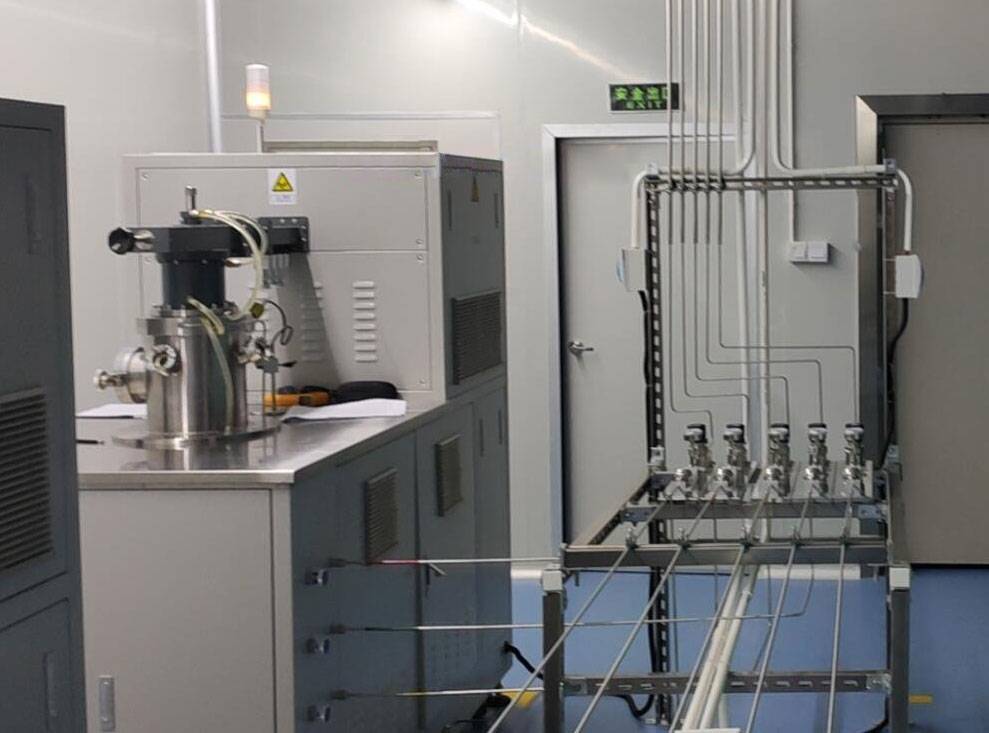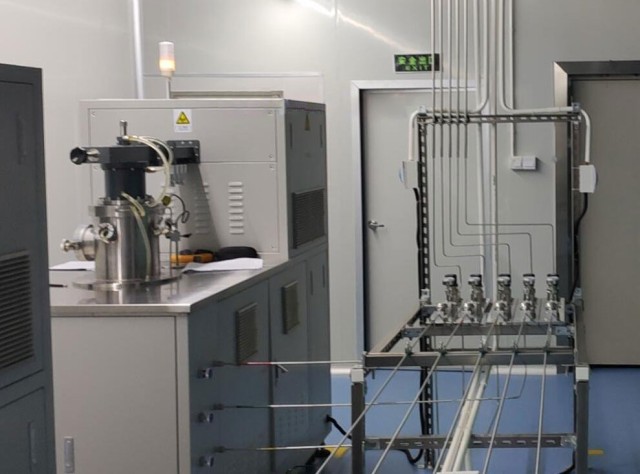Process Introduction
CVD Technology Overview
Chemical Vapor Deposition (CVD) is a sophisticated film-forming technology that leverages gaseous substances to create solid films on the surfaces of wafers through controlled chemical reactions. This process is indispensable in the fabrication of Integrated Circuit (IC) chip devices, where it is crucial for producing insulating films and various metal film material layers. These layers include tungsten, tungsten silicide for metal layer connections, and thin barrier layers, all of which are meticulously formed through precision CVD processes.
In addition to the standard CVD methods, Plasma-Enhanced CVD (PECVD) is employed to form critical insulating layers that serve as protective barriers for the electronic structure of integrated circuits. PECVD enhances the deposition process by incorporating plasma, which accelerates the chemical reactions and allows for the creation of complex thin films with superior properties.
CVD technology extends beyond semiconductor applications, finding utility in coating gas turbine components with metals to enhance their resistance to corrosion and wear. This broader application exemplifies the versatility and robustness of CVD, which supports various industrial operations by significantly extending the service life of equipment.
Modern CVD processes are highly advanced, incorporating the latest innovations in instrumentation and automation to ensure reliable and high-yield operations. These processes enable the production of a variety of coatings, including Ti, Zr, and Cr-based nitrides, carbides, and carbonitrides, as well as high-quality α- and κ-alumina (aluminum oxide) films. The precision and control inherent in CVD make it a proven technology for a wide array of coating applications, from semiconductor fabrication to industrial component protection.

CVD Transfer System Components
Gas Cabinet
In the cleanroom environment, particularly within the sub-fab layer, the gas cabinet plays a crucial role in the storage and distribution of inert gases such as nitrogen and argon, as well as specialized electronic gases. These gases are essential for various semiconductor manufacturing processes, including chemical vapor deposition (CVD). The gas cabinet is designed to ensure the safe and efficient delivery of these gases to different pieces of equipment within the cleanroom.
Gases are stored in cylinders within the cabinet and are regulated through a series of components to ensure the correct pressure and flow rate. Key components include manual valves, regulators, pneumatic switching valves, and check valves. These elements work together to control the gas flow and pressure, ensuring that the gases are delivered to the appropriate equipment at the required specifications.
Specialized electronic gases, which are highly reactive and potentially hazardous, are stored in dedicated gas cabinets. These cabinets are equipped with advanced safety features to prevent and control accidental leaks. A critical component of these specialized gas cabinets is the gas detector, which continuously monitors the environment for any signs of gas leakage. If a leak is detected, the system immediately triggers the closure of all valves within the cabinet, thereby minimizing the risk of exposure to the environment.
The entire gas cabinet system is a sophisticated network of fluid components, designed to maintain a safe and controlled environment for gas distribution. This system is essential for the smooth operation of semiconductor manufacturing processes, ensuring that gases are delivered accurately and safely to the various pieces of equipment within the cleanroom.
Gas Box Equipment Gas Cabinet
The gas box equipment gas cabinet is a critical component in the CVD chemical vapor deposition process, designed to manage and control the flow of various process gases with high precision. This cabinet is equipped with a variety of essential gas handling components, including diaphragm valves, mass flow meters (MFCs), and check valves. These components work in tandem to ensure that the gases are delivered at the correct flow rates and pressures, which are crucial for the successful deposition of thin films on semiconductor wafers.
One of the standout features of the gas box is its specialized discharge system. This system is integral to the safe operation of the equipment, as it allows for the detection of any gas leaks. The discharge system is connected to a special gas detector that monitors the environment within the cabinet. In the event of a gas leak, the detector can quickly identify the issue, triggering an immediate response to close all valves and prevent any hazardous gases from escaping into the surrounding environment.
The gas box's design also includes robust safety mechanisms to protect against accidental gas releases. These mechanisms ensure that the equipment can operate safely in a controlled environment, minimizing the risk of contamination or harm to personnel. The combination of precise gas control and advanced safety features makes the gas box an indispensable part of the CVD process, contributing to the overall efficiency and reliability of thin film deposition systems.
CVD Reactor
The core component of the CVD equipment is the reactor, where the wafer is transferred for the thin film deposition process. This reactor houses several critical elements, including the reaction chamber, gas mixing nozzle, bottom heater, reaction chamber pressure sensor, pressure unloading valve, and gas piping. The gas mixing nozzle ensures that the gases from the gas cabinet are uniformly mixed before being introduced into the reaction chamber. This uniform mixture is crucial for the deposition of high-quality films on the wafer surface.
The reaction chamber itself is a sophisticated environment designed to facilitate the chemical reactions necessary for thin film deposition. It is equipped with a pressure sensor and a pressure unloading valve to maintain precise control over the chamber's internal pressure. This pressure control is essential for creating the vacuum environment required for the deposition process. The vacuum pump, located downstream, works in tandem with these components to maintain a consistent vacuum, ensuring that the pressure within the chamber remains at the desired level.
Heat is another critical factor in the CVD process. The bottom heater under the wafer tray provides the necessary thermal energy to drive the chemical reactions. This heating element ensures that the substrate reaches the optimal temperature for film formation, enhancing the quality and uniformity of the deposited film. The excess gas, after participating in the deposition process, is efficiently discharged through the bottom pipeline, preventing any buildup that could interfere with the process.

Safety is paramount in the operation of a CVD reactor, especially when dealing with special gases. The reaction chamber is connected to an external discharge system that includes a special gas detector. This detector monitors for any accidental leakage of special gases into the environment. In the event of a leak, the interlocking function can immediately shut down all valves in the gas cabinet, ensuring a swift and effective response to potential hazards. This integrated safety mechanism is essential for maintaining a secure and controlled environment for the deposition process.
The CVD reactor's design and operation are meticulously calibrated to ensure the deposition of high-quality thin films. The combination of precise gas mixing, controlled pressure, optimal heating, and robust safety measures creates an environment where the chemical vapor deposition process can thrive, resulting in films with minimal defects and superior performance. This advanced reactor is not only crucial for the current generation of semiconductor devices but also holds promise for future innovations in nanotechnology and beyond.
Exhaust System
The exhaust system in a Chemical Vapor Deposition (CVD) process plays a crucial role in maintaining the vacuum environment necessary for thin film deposition. This system is composed of several key components, including a butterfly valve, a residual gas collector (Trap), an optional molecular pump, and a dry pump. These components work in concert to ensure the efficient removal of gases and by-products generated during the CVD reaction.
The butterfly valve is particularly important as it allows for precise control of the pressure within the reaction chamber. By adjusting the angle of the valve, operators can maintain the optimal pressure conditions required for the deposition process. This control is essential for ensuring that the CVD reaction proceeds smoothly and that the quality of the deposited film is consistent.
In addition to controlling pressure, the exhaust system also manages the by-products generated during the CVD process. These by-products, which can include solid particles, are collected by the residual gas collector (Trap) to prevent them from clogging the vacuum lines. Regular maintenance, including the replacement of the Trap, is necessary to ensure the continuous and efficient operation of the exhaust system.

The dry pump, along with the optional molecular pump, is responsible for creating and maintaining the vacuum environment within the reaction chamber. These pumps work together to evacuate gases and by-products, ensuring that the pressure remains at the desired level. The molecular pump, when used, provides additional pumping speed and can achieve higher vacuum levels, which are often necessary for advanced CVD processes.
Overall, the exhaust system is a critical component of the CVD process, enabling the creation and maintenance of a controlled vacuum environment. This system not only ensures the efficient operation of the CVD reactor but also helps to protect the equipment from damage caused by by-products and gas leaks.
Related Products
- Customer Made Versatile CVD Tube Furnace Chemical Vapor Deposition Chamber System Equipment
- Chemical Vapor Deposition CVD Equipment System Chamber Slide PECVD Tube Furnace with Liquid Gasifier PECVD Machine
- Split Chamber CVD Tube Furnace with Vacuum Station Chemical Vapor Deposition System Equipment Machine
- Multi Heating Zones CVD Tube Furnace Machine Chemical Vapor Deposition Chamber System Equipment
- Inclined Rotary Plasma Enhanced Chemical Vapor Deposition PECVD Equipment Tube Furnace Machine
Related Articles
- CVD furnace for the growth of carbon nanotubes
- Advantages and Disadvantages of Chemical Vapor Deposition (CVD)
- The Versatility of Tube Furnaces: A Guide to Their Applications and Benefits
- Exploring the Key Characteristics of Tube Heating Furnaces
- PECVD Furnace A Low-Power and Low-Temperature Solution for Soft Matter











